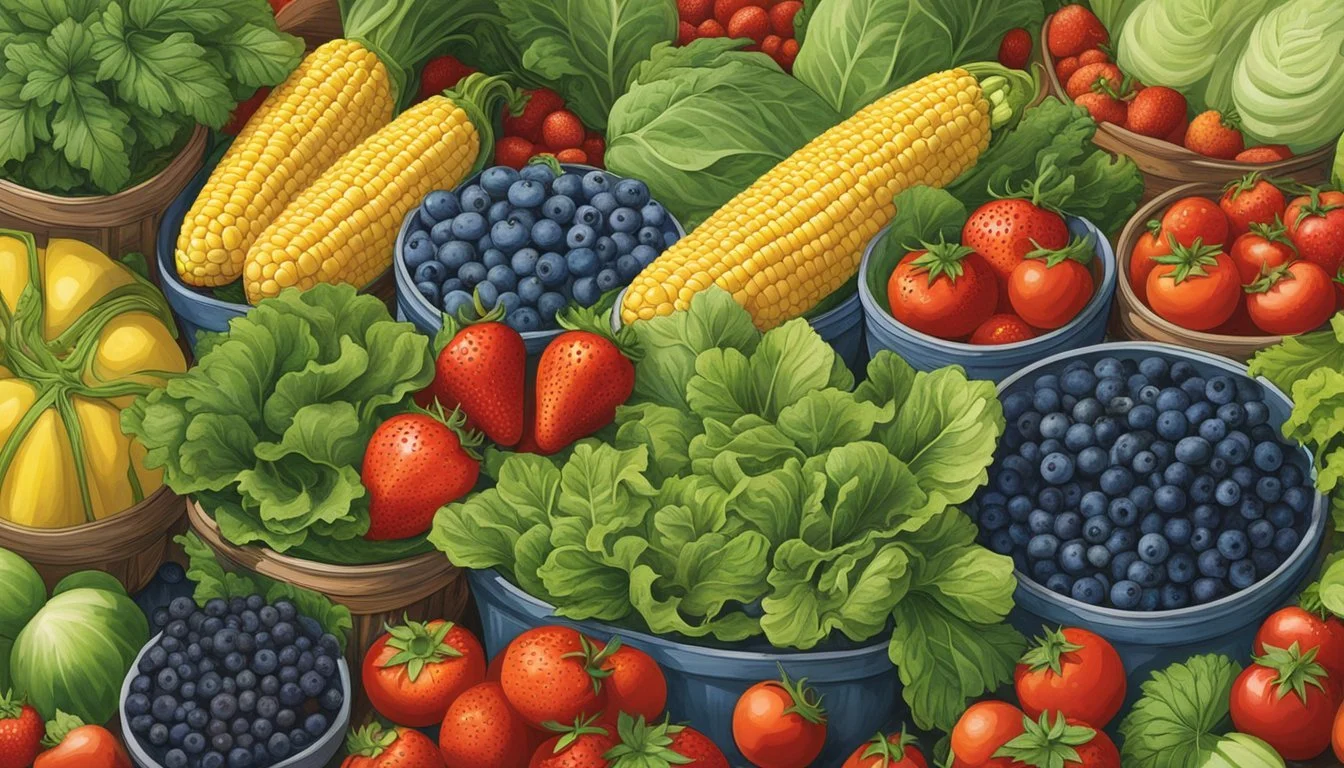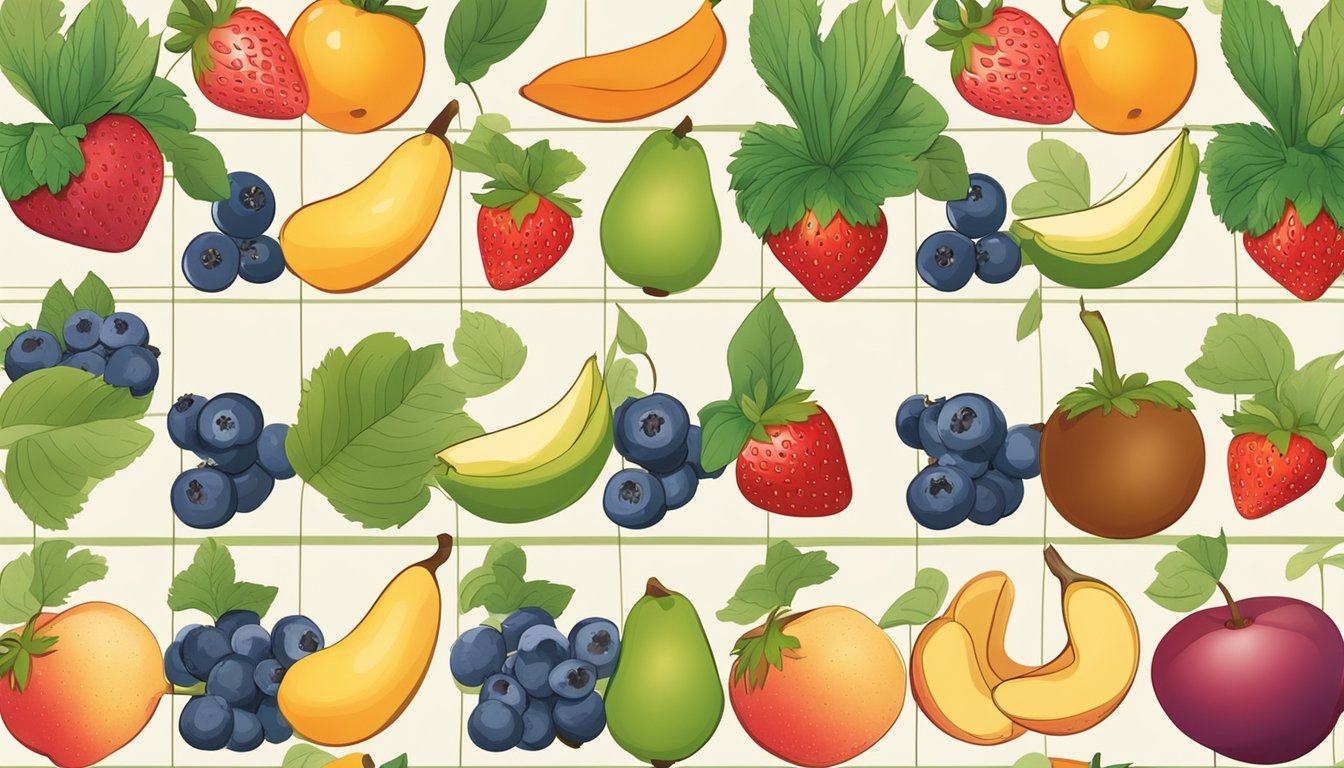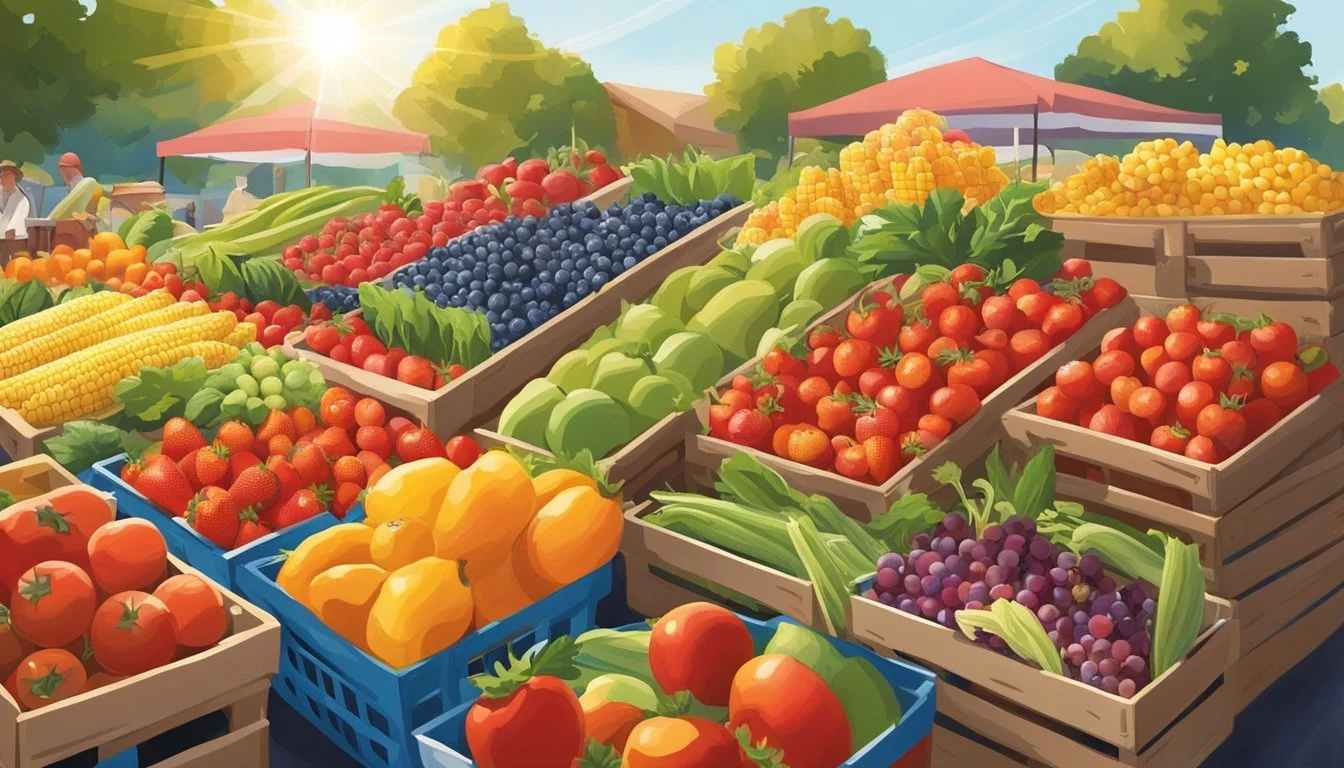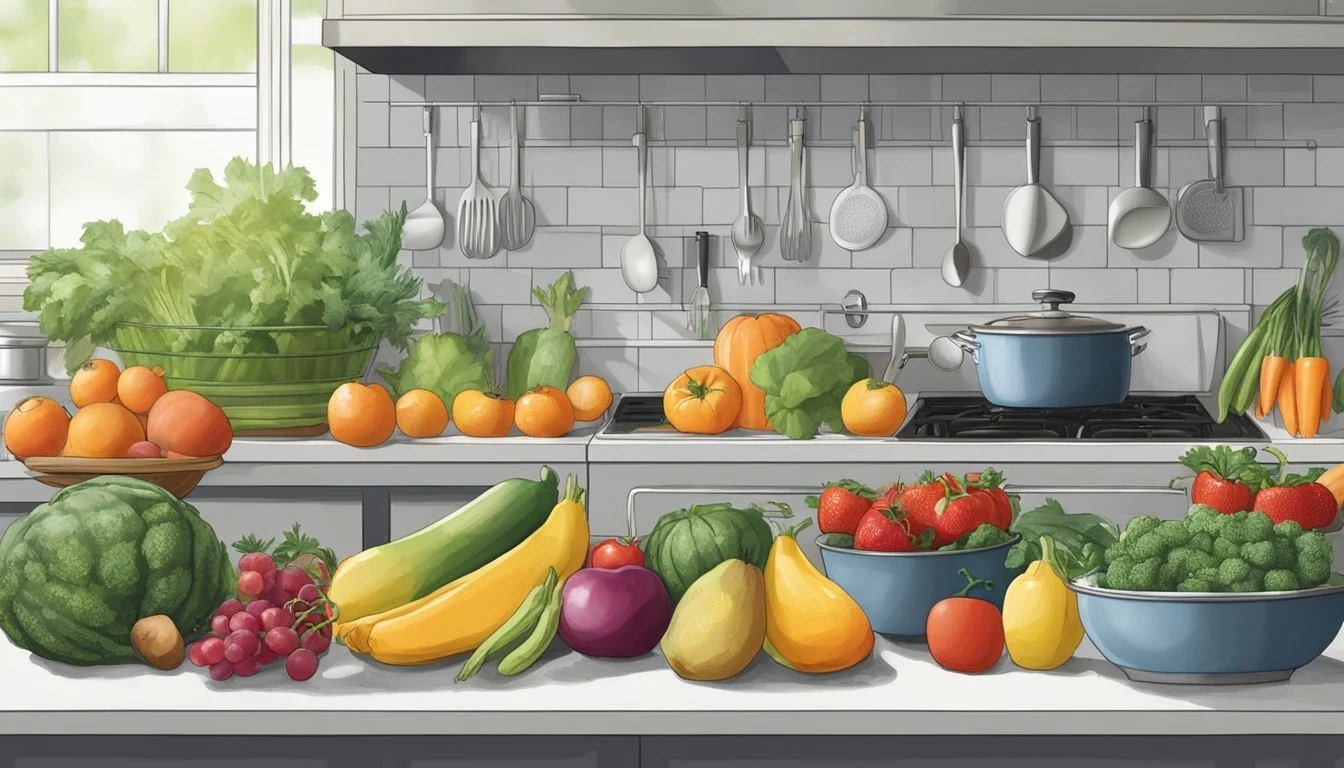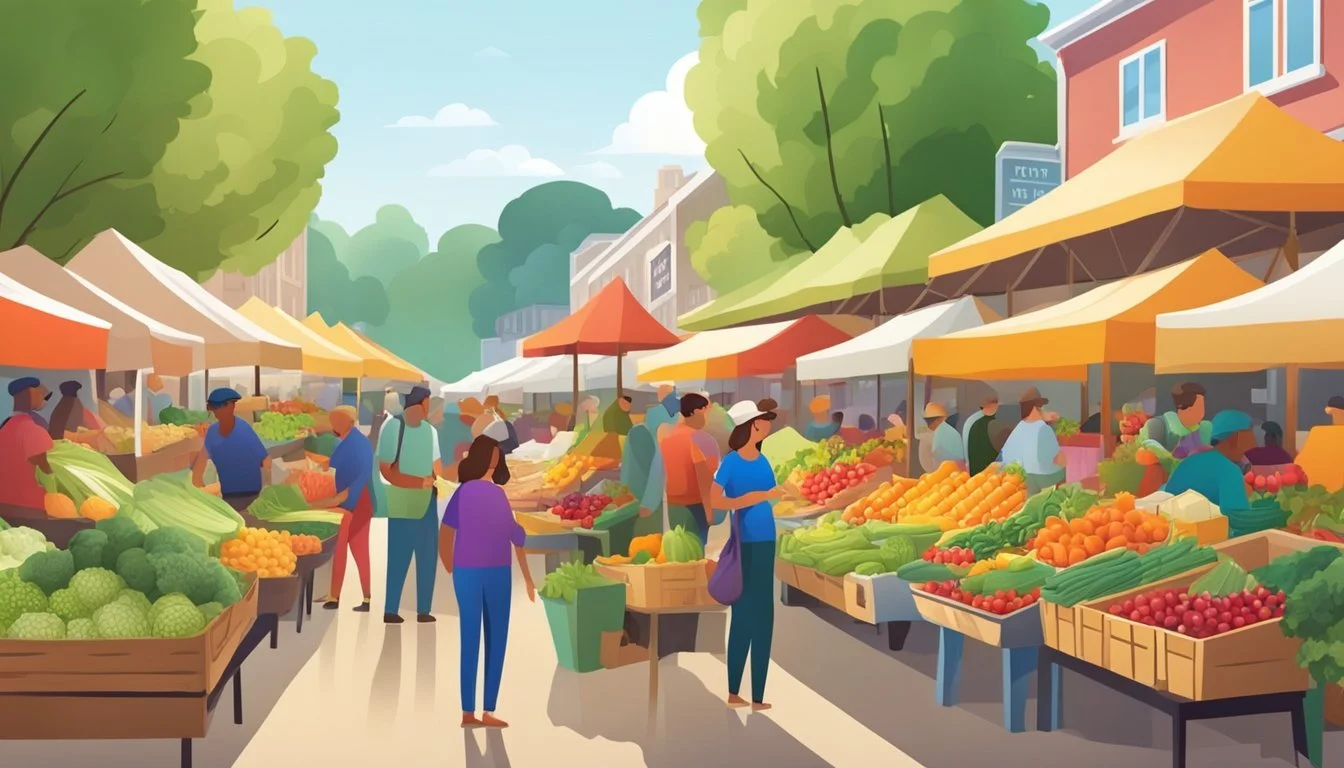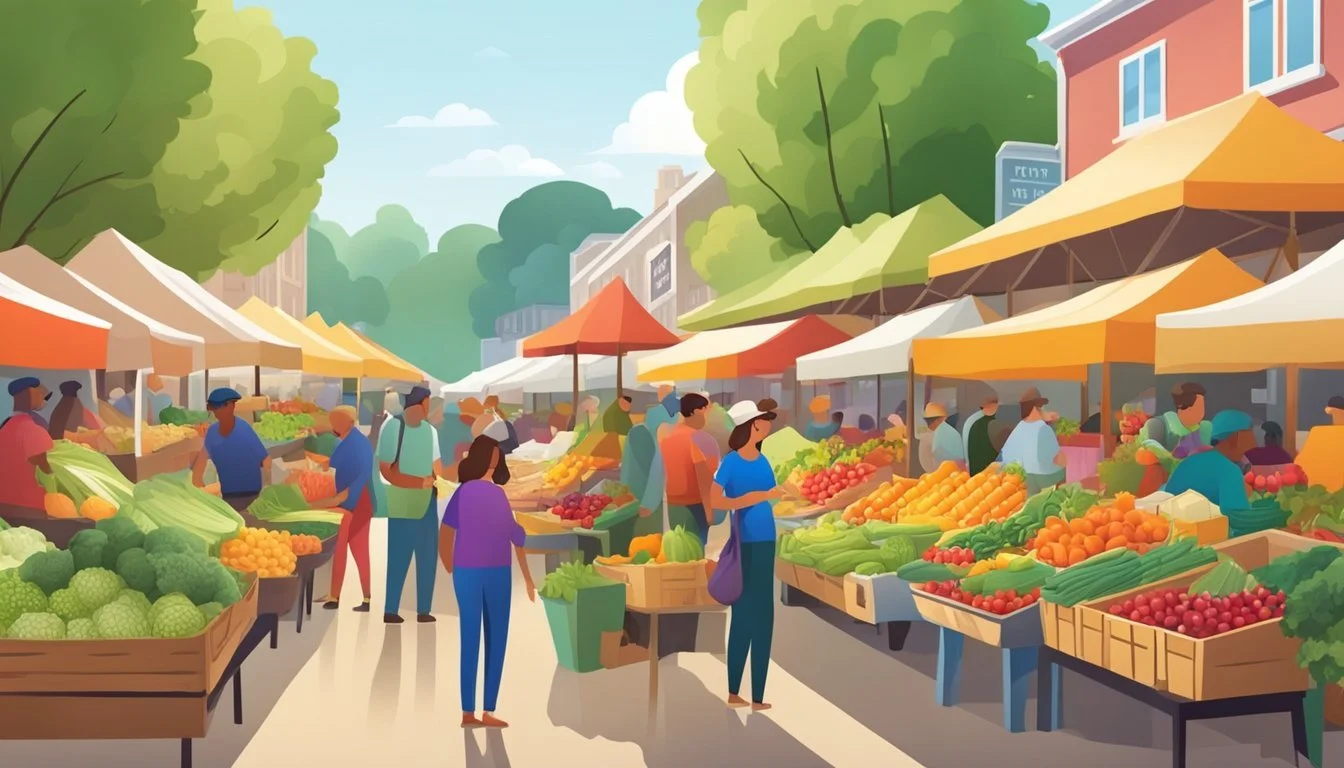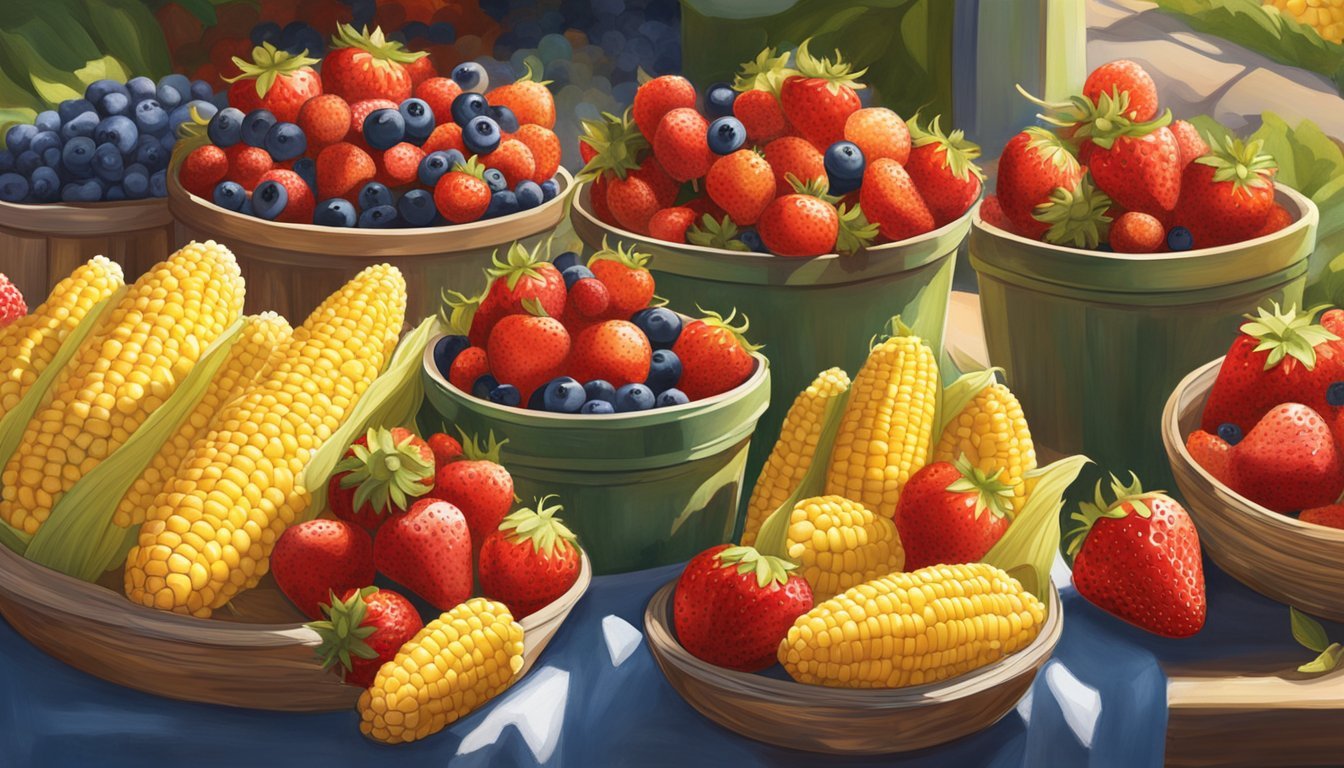Rhode Island Seasonal Fruit & Vegetables in July
Your Guide to Fresh Produce
This Article is Part of our Rhode Island Seasonal Fruit & Veg Calendar
In Rhode Island, the month of July marks a period of abundance for local produce, with a variety of fruits and vegetables reaching their peak. Local farms and markets become vibrant hubs of activity, showcasing the state's rich agricultural offerings. The summer climate in Rhode Island provides ideal conditions for a plethora of produce to thrive, allowing residents and visitors alike to enjoy the freshest, most flavorful selections straight from the field.
Fruits such as blueberries, raspberries, and peaches grace the tables with their ripe, juicy presence, reflecting the quintessential tastes of summer. These seasonal fruits not only offer exceptional taste but also support local economies and sustainable farming practices. Vegetables including tomatoes (What wine goes well with tomatoes?), summer squash, and cucumbers (how long do cucumbers last?) flourish, ready to be harvested and enjoyed. They form the backbone of many seasonal dishes, from fresh salads to grilled vegetable platters, offering both nutrition and taste that embody the essence of July in Rhode Island.
To experience the full range of what the season has to offer, one finds an array of other produce such as green beans, sweet corn, and peppers, each contributing unique flavors and textures to the summer palette. Locavores and culinary enthusiasts alike revel in the opportunity to incorporate these fresh ingredients into their cooking, celebrating the local harvest that reflects the vibrant culinary landscape of Rhode Island in the heart of summer.
Availability Calendar
In July, the Rhode Island seasonal produce calendar embodies the full swing of summer with a vibrant selection of fruits and vegetables. The farms and markets teem with fresh and nutritious produce during this month.
Fruits:
Blueberries: These small but mighty fruits are at their peak, perfect for pies or fresh eating.
Peaches: Juicy and ripe, they are a must-have for summer desserts or as a sweet snack.
Honeydew: With its subtle sweetness, honeydew melons are refreshing on a hot July day.
Cantaloupe(how long does cantaloupe last?): This melon is another sweet treat that's ready to be enjoyed, especially in fruit salads.
Vegetables:
Corn: Sweet corn is a July favorite, ideal for barbecues and summer picnics.
Tomato: From classic red to heirloom varieties, tomatoes are in abundance and perfect for salads and sauces.
Beans: Fresh beans are versatile, whether steamed, sautéed, or added to soups.
Squash: Both summer squash and zucchini are readily available and can be used in a variety of dishes.
Cucumbers: Crisp and refreshing, cucumbers are perfect for salads or as a cooling snack.
Eggplant (What wine goes well with eggplant?): With its unique texture and taste, eggplant (What wine goes well with eggplant?) is a great addition to grill menus or Mediterranean recipes.
Though not typically harvested in July, Rhode Island's apple variety is more commonly expected in the fall months. Likewise, customers eager for apples might need to wait for later in the season to experience the freshest local picks. The availability of produce can vary based on specific weather conditions and farming practices, so it's always best to check with local farmers or markets for the most current information.
Summer Staples
July marks the height of summer in Rhode Island, showcasing a bounty of vibrant fruits, vegetables, and an array of herbs. During this period, local produce is at its peak, offering the freshest flavors for any culinary creation.
Fruits
The warmth of the summer sun nurtures a variety of fruits in Rhode Island. Orchards and gardens are abundant with:
Blueberries: These berries are plump and sweet, ideal for baking or fresh eating.
Peaches: Juicy and fragrant, they are perfect for cobblers or enjoyed as a hand fruit.
Raspberries: Delicate and tangy, suitable for preserves or toppings.
Blackberries: These are known for their rich color and deep flavor, great in desserts.
Plums: With a balance of sweet and tart, plums are versatile in both sweet and savory dishes.
Nectarines: Similar to peaches, they have a smooth skin and are equally delicious.
Vegetables
Gardeners and farmers are busy harvesting a range of vegetables during this time:
Tomatoes: Ripe and full-flavored, ideal for salads, sauces, and sandwiches.
Cucumbers: Crisp and refreshing, commonly used in salads or pickling.
Eggplant: With a meaty texture, it is a staple in dishes like ratatouille (What wine goes well with ratatouille?).
Squash: Includes zucchini and summer squash, which are tender and quick to cook.
Corn: Sweet and juicy, often eaten right off the cob or incorporated into salads.
Green Beans: Snappy and versatile, good for steaming, sautéing, or in casseroles.
Peppers: Ranging from sweet to spicy, peppers add flavor and color to any dish.
Herbs
Fresh herbs (how long do fresh herbs last?) are plentiful and add a burst of flavor to summer dishes:
Basil: (how long does basil last?) Sweet with a peppery edge, commonly paired with tomatoes.
Parsley: Bright and fresh, it can be a garnish or key ingredient.
Cilantro: (how long does cilantro last?) Offers a citrusy note to tacos, salsas, and Asian dishes.
Dill (how long does dill last?): Feathery and aromatic, often used with fish or in pickles.
Mint: Cool and refreshing, a staple in drinks and summer salads.
Rosemary: Piney and potent, it pairs well with grilled meats and vegetables.
Thyme: Subtly earthy, it's a versatile herb for marinades, sauces, and roasts.
Picking Tips and Techniques
When venturing out to harvest fruits and vegetables in Rhode Island during July, it's crucial to recognize the signs of ripeness to ensure one gathers the freshest produce. For berries, like strawberries and blueberries which are abundant in this period, they should be plump and vibrant in color. They should detach easily from the stem, indicating they are ripe and at peak flavor. It's important to handle berries gently to prevent bruising.
For vegetables such as tomatoes, look for a firm texture and uniform color. When they easily come off the vine with a light twist, they are ready for harvest. Leafy greens, commonly in season, should appear vibrant and crisp, without any signs of wilting.
Here is a quick reference for peak ripeness traits:
Berries: Deep, uniform color; easily picked from stem.
Tomatoes: Bright, even color; slight give upon touch.
Leafy Greens: Crisp, vibrant leaves.
One must also consider the best way to store freshly picked produce. Berries are delicate and should be refrigerated as soon as possible. Tomatoes, on the other hand, can be kept at room temperature until they're fully ripe before moving them to a cooler setting if not used immediately.
The following list details the collection essentials for a July harvest session:
Basket or container for gentle transport of berries
Protective gloves for handling prickly plants
Sharp scissors or pruners for clean cuts on vegetables like greens
Remember that the weather and variety may affect the precise harvest dates for fruits and vegetables, which means one may need to be flexible and check with local farms for the best picking times.
Local Farms and Markets
In Rhode Island, local farms and markets are bustling hubs for fresh summer produce. Consumers can indulge in a variety of fruits and vegetables, harvested at the peak of freshness. The Neutaconkanut Hill Farmers Market, located in Providence, operates on Mondays from 2 pm to 6 pm, providing shoppers with an assortment of farm-fresh options, including distinctive Asian and African vegetables.
For those residing in the Newport area, the Aquidneck Growers Market at Stoneacre Garden opens its doors on Saturdays from 9 am to noon. Throughout the summer months, Rhode Island’s markets are known for their fresh fruits, such as berries, apples, peaches, and summer staples like corn and tomatoes.
Seasonal Highlights:
Fruits: Berries, Apples, Peaches
Vegetables: Corn, Tomatoes, Asian and African Greens
Visitors can also explore the Pell Elementary School market in Newport, which is active on Saturdays from May through October, offering a morning to early afternoon window (9 am to 1 pm) for purchasing local goods.
Local markets often foster a sense of community and support for sustainable farming. Rhode Islanders can take pride in contributing to their local economy while enjoying the freshest produce the state has to offer. The markets not only provide fresh food but also an opportunity for direct interaction with the growers, ensuring customers are well-informed about the produce they're buying.
Health Benefits of Seasonal Eating
Eating fruits, vegetables, and herbs that are in season has multiple health benefits. These foods are at their peak in terms of flavor and nutrition. Seasonal produce often contains higher levels of antioxidants and phytochemicals at the time of harvest, which can enhance the immune system, decrease inflammation, and promote overall bodily functions.
The less time there is between harvest and consumption, the fewer nutrients fresh produce loses. For instance, vitamin C is highly susceptible to degradation; seasonal eating minimizes this loss. Here's what people can expect from Rhode Island's seasonal offerings in July:
Fruits: Berries are abundant and rich in vitamins and fiber.
Vegetables: Leafy greens like spinach and kale are high in iron and calcium.
Herbs: Fresh herbs, such as basil, provide concentrated flavors and health-promoting oils.
Nutritional Table for July Produce in Rhode Island
Produce Type Nutrient Content Fruits High in vitamins A, C, and fiber Vegetables Rich in minerals like iron and calcium Herbs Contain essential oils and antioxidants
The practice of eating seasonally also promotes a diverse diet, which is a cornerstone of good health. Incorporating a variety of fruits, vegetables, and herbs can lead to a broader intake of essential nutrients and reduce the risk of chronic diseases. Seasonal eating supports local economies and reduces the carbon footprint, making it a sustainable choice for individuals aware of their health and the environment.
Cooking and Preserving Seasonal Produce
In July, Rhode Island kitchens bustle with the vibrant hues of freshly harvested produce. Cooking with seasonal vegetables like tomatoes, squash, cucumbers, and peppers offers not only peak flavor but also nutritional benefits. These summer staples can be transformed into a myriad of dishes, from a refreshing cucumber salad to a hearty squash casserole.
Tomatoes burst with juiciness in July, perfect for salsas or a classic tomato sauce. For preservation, they can be canned or dried, ensuring a taste of summer even in colder months. Squash, both summer and zucchini, are versatile for grilling or sautéing, while also being an excellent candidate for pickling.
Cucumbers cool the palate and are ideal for pickling to create crunchy dills or sweet bread-and-butter pickles. Grilled or roasted peppers, on the other hand, elevate any dish with a smoky sweetness and can be easily preserved by freezing or making relishes.
A bounty of fresh herbs in July—like basil, parsley, and cilantro—complements the other produce well. They impart aromatic flavors to any dish and can be chopped and frozen in oil for long-term storage.
Preservation Method Suitable Produce Canning Tomatoes, Peppers Pickling Cucumbers, Squash Drying Tomatoes, Herbs Freezing Peppers, Herbs
When cooking with these seasonal delights, one can confidently employ simple techniques to let the natural flavors shine. It's easy to preserve the excess through methods like canning or freezing, so that these summer flavors may grace the table throughout the year.
Sustainability and Community Impact
Rhode Island’s local farms play an instrumental role in the sustainability and vitality of their communities, particularly during the abundant month of July. The integration of fresh produce from these farms into the daily lives of residents is more than a commercial transaction—it fosters a resilient food system and nourishes the community fabric.
Local farms reduce the overall carbon footprint by minimizing the distance food travels from farm to plate, leading to fresher, nutrient-rich offerings.
Community engagement through volunteer opportunities, such as gleaning, connects individuals with their local food systems, promoting a cooperative spirit.
By ensuring access to fresh, raw produce at farmers' markets, Rhode Island supports a model of sustainability that benefits both the environment and its residents. Farms employing sustainable techniques help preserve the ecosystem for future generations, contributing to a healthier environment.
The positive impact extends to marginalized communities, with efforts to provide access to affordable, healthy food options. Programs and initiatives that convert urban spaces into productive gardens allow for the empowerment of local residents through education and participation in growing their own food.
Farm-to-market ventures are an investment in Rhode Island's future, enhancing the overall well-being of the society by:
Encouraging local consumption of in-season produce.
Reducing dependency on long-distance food supply chains.
Fostering economic sustainability within the farm community.
This multi-layered approach to local food systems is a testament to how sustainability and community engagement can be cultivated hand-in-hand, solidifying Rhode Island's commitment to both its land and people.
Preparing for the Coming Seasons
As Rhode Island transitions into the latter part of the growing season, gardeners and local producers shift their focus towards the fall and winter harvests. The period from August through September marks an important preparation phase for the cooler months ahead.
August in Rhode Island ushers in the early stages of fall gardening. During this time, it is crucial to plan and begin sowing crops that flourish in autumn's cooler temperatures. One can start with root vegetables such as beets and carrots, as they can tolerate the moderate climate. Additionally, planting leafy greens like spinach and kale during August will ensure a bountiful harvest in the fall.
By September, it is essential to stay updated with the seasonal calendar to optimize harvest times. The fall harvest includes a variety of hearty vegetables; knowing their peak seasons ensures maximum freshness and flavor. For example, winter squash and pumpkins are autumn staples that should be monitored for proper maturity.
Preparation should also account for the preservation of the summer's bounty. One can consider canning, drying, or freezing surplus fruits and vegetables to enjoy during the winter months when fresh produce is less abundant.
Here is a brief list of tasks to consider for a fruitful fall and winter:
Reviewing the Harvest Calendar: Be aware of which crops will be peaking and plan accordingly.
Planting Fall Crops: Begin sowing seeds for beets, carrots, leafy greens, and other cool-season plants.
Protection: Prepare to shield sensitive crops from early frost with covers or cloches.
Preservation: Plan for canning or freezing summer produce to extend their availability into winter.
Adhering to these strategies can yield a successful transition into the seasons of fall and winter, ensuring that the garden remains productive and the harvest is plentiful.
Recipes and Pairings
In July, Rhode Island celebrates a bounty of fresh produce, offering a plethora of flavors for the culinary enthusiast. Utilizing vegetables like beets and carrots can add a pop of color and a nutritional boost to any plate. Roasted beets with goat cheese and walnuts create a rich blend of earthy and tangy flavors, making it a perfect side dish or salad topper.
Tomatoes are at their peak, and their vibrant taste is ideal for a classic tomato basil crostini. This simple appetizer marries the freshness of basil with the acidity of tomatoes on a crunchy bread base.
For a refreshing twist, incorporating blueberries into a basil blueberry margarita delivers a summery, sweet, and herbaceous cocktail, perfect for a warm July evening. The antioxidants in blueberries make this indulgence a slightly guilt-free pleasure.
Here's a brief table outlining potential recipes and their key July ingredients:
Recipe Key Ingredients Roasted Beets with Goat Cheese Beets, Goat Cheese Tomato Basil Crostini Tomatoes, Fresh Basil Basil Blueberry Margarita Blueberries, Basil
Complementing these dishes with other in-season vegetables such as cucumbers, corn, and eggplant extends the flavors of the season to the entire meal. Eggplant parmesan (What wine goes well with eggplant parmesan?) or a grilled corn salad with cilantro and lime can act as deliciously satisfying mains or sides.
Rhode Island's July harvest also provides a variety of herbs like basil, cilantro, dill, and mint which can be used to enhance any dish. A dollop of vegan basil walnut pesto can transform simple pasta into a vibrant main course, highlighting the robust flavors of fresh herbs.
Chefs and home cooks alike will find no shortage of inspiration from Rhode Island's July produce for creating dishes that are as visually appealing as they are palate-pleasing.
Programs and Incentives
Rhode Island actively promotes access to fresh produce through various programs and incentives aimed at enhancing community health. The state’s initiatives resonate with a commitment to support local agriculture while ensuring nutritional equity among its residents.
Bonus Bucks Program This incentive effectively doubles the purchasing power of low-income families using SNAP benefits at farmers markets. For every SNAP dollar spent, the program adds a Bonus Buck, facilitating an affordable means for these households to access fresh fruits and vegetables readily available in July.
SNAP Eat Well, Be Well Pilot Incentive Program Under this initiative, SNAP participants receive additional value when they buy fresh produce. The state offers 50 cents in rewards for every SNAP dollar spent on eligible fresh fruits and vegetables, credited directly to the purchasers' EBT cards for other SNAP-approved purchases (with a monthly cap).
WIC Farmers Market Nutrition Program (FMNP) WIC participants are empowered through the FMNP to purchase fresh, local produce at farmers markets. This program not only supports nutritional needs but also bolts the local economy by funneling funds directly to small-scale farmers.
Local Impact
Community engagement is further augmented by seasonal farmers markets across Rhode Island. These markets serve as hubs for local commerce and nutrition education, often featuring a range of vendors who offer a bounty of fresh July produce, from juicy berries to crisp greens.
Entity Program Involvement State Manages SNAP and Bonus Bucks incentives Community Hosts farmers markets and outreach Local Provides fresh produce for programs WIC Offers FMNP for locally sourced produce
By employing these initiatives, Rhode Island endeavors to ensure that all community members have continuous access to nutritious, seasonal food choices while supporting local farmers and the state’s agriculture.v

